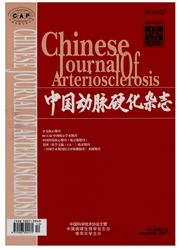

 中文摘要:
中文摘要:
目的观察不同剂量甲醛对人脐静脉内皮细胞一氧化氮含量的影响,分析甲醛诱导内皮细胞损伤在心血管疾病发病中的意义。方法将人脐静脉内皮细胞株分别与不同浓度甲醛(分别为0、5、10、20、40和80μmol/L)的DMEM培养基孵育,同时以过氧化氢(100μmol/L)为阳性对照组,抗氧化剂维生素C(100mg/L)为保护组。共培养24h后,分光光度法检测乳酸脱氢酶漏出量;硫代巴比妥法检测细胞上清液中丙二醛浓度;硝酸还原酶法测定培养液中一氧化氮浓度;生化分析法测定内皮细胞一氧化氮合酶活性;免疫细胞化学法测定内皮型一氧化氮合酶和诱导型一氧化氮合酶的蛋白表达;RT-PCR法测定内皮型一氧化氮舍酶和诱导型一氧化氮合酶的mRNA表达。结果不同浓度甲醛呈剂量依赖性地促进细胞乳酸脱氢酶漏出,促进内皮细胞上清液丙二醛和一氧化氮的产生;降低内皮型一氧化氮合酶的活性,抑制内皮型一氧化氮舍酶在蛋白和基因水平的表达;增加诱导型一氧化氮舍酶活性,促进诱导型一氧化氮合酶在蛋白和基因水平的表达。结论甲醛诱导人脐静脉内皮细胞损伤,机制可能与其抑制内皮型一氧化氮合酶的活性及表达,诱导诱导型一氧化氮合酶的活性及表达,从而诱导内皮细胞产生过多的一氧化氮有关:维生素C通过降低一氧化氮产生,减轻甲醛诱导的内皮细胞损伤。
 英文摘要:
英文摘要:
To explore the change of nitric oxide in human umbilical vein endothelial cells induced by different dose of formaldehyde and the mechanisms of the nitric oxide change, Methods Human umbilical vein endothelial cells (hU- VECs-12) were cultured in dulbecco's minimum essential medium (DMEM) containing 10% fetal bovine serum. At 80% confluence, cells were washed with D-Hank's fluid and cultured in DMEM containing 1% fetal bovine serum for 24 h. Cells were incubated in the presence or absence (control) of formaldehyde. In order to test the dose-effect of formaldehyde -induced endothelial cells change of nitric oxide, the cells were treated with formaldehyde at the dose of 0.0μmol/L and 5, 10, 20, 40, 80 μmol/L for 24 h respectively. To explore the injuring mechanism of formaldehyde on endothelial cells, hydrogen peroxide ( 100 μmol/L), a potent free radical, was selected as a positive control; Vitamin C ( 100 mg/L), an anti-oxidant medicine, was selected as a protective group. After 24 h, the transudation content of lactate dehydregenase was observed by colorimetry reaction, the level of malondialdehyde in supernatant-conditioned media of ceils was measured by thiobituric acid reaction (TBA) method, the level of nitric oxide in in culture medium was observed to evaluate the influence feature of formaldehyde by nitrate reductase methed, the nitric oxide synthase activity was measured by biochemical method, the protein and mRNA level of inducible nitric oxide synthase and endothelial nitric oxide synthas were examined by immunohistochemistry and RT-PCR approach respectively to elucidate the injuring mechanism. Results Formaldehyde conspicuously inhibited the activity of Endothelial nitric oxide synthas, expression of endothelial nitric oxide synthas protein and endothelial nitric oxide synthas mRNA. Formaldehyde induced the activity of inducible nitric oxide synthase, expression of inducible nitric oxide synthase protein and inducible nitric oxide synthase mRNA, and increased the producti
 同期刊论文项目
同期刊论文项目
 同项目期刊论文
同项目期刊论文
 期刊信息
期刊信息
